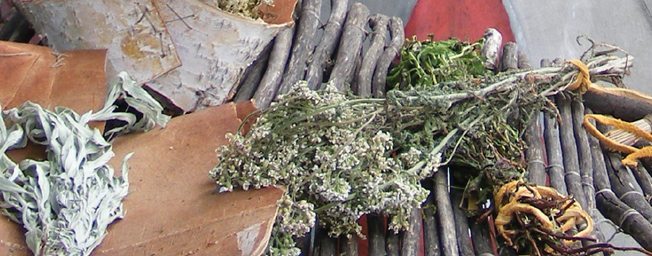by David Young, Robert Robers, and Russell Willier
A Cree Healer and His Medicine Bundle offers readers information often
reserved exclusively for Native American healers. While talking about
these ancient medicines openly was once taboo, the threat of losing 
Artemisia frigida
Sage, Sagebrush, Prairie Sagewort, Pasture Sage
Willier calls this plant mostoswiyikwaskwa or Buffalo Grass.
The leaves are used for incense and in many combinations for protection. A very small portion of leaves can be boiled for migraine.
Additional Cree Information
Mostoswiyikiwaska means “good tasting or delicious cow plant.” The Cree and others use various Artemisia species for incense and ceremonial purposes. Blackened and weathered leaves were powdered and applied to baby skin rashes, while teas were prepared for stomach complaints.
Folk Uses
The whole plant is infused for bathing. The tincture in cold water reduces stomach hyperacidity. Those troubled by nighttime indigestion or between-meal discomfort will find effective relief. For more chronic cases, Michael Moore (1989) suggests taking the tincture three times daily, in the morning, in the afternoon, and before bed, followed by Alfalfa or Red Clover tea. Vinegar tinctures or well-diluted alcohol tinctures can be applied to the sides of the face and the temples for headaches accompanied by bloodshot eyes. Infusions of the leaves make a good vermifuge. The hot tea is strongly diuretic, and is a moderate laxative for those with atonic constipation. It increases skin secretions, thereby lowering body temperature. Dr. William Cook (1869) recommended warm infusions for their stimulating, diffusive, and diaphoretic properties in malaria, typhoid, rheumatic fever, and scarlatina. It is taken cool for congestive amenorrhea, pelvic engorgements with atony, rheumatism, and diuretic action. The dose is one-half to one drachm in hot lemonade every three hours. Artemisia prefers dry and sandy soil, requiring more southern exposure the further north the plants grow.
…
Betula papyrifera
Paper Birch, White Birch
Willier calls this plant waskwiyî or Birch.
Small sapling stems are used in combinations for blood purification, fever, and conditions of the mind.
Additional Cree Information
The white rotten wood is boiled by the Cree with Labrador Tea. This extract was dried and powdered and used as a dusting powder on chapped skin. The dry, powdered rotten wood was used as baby powder. For gonorrhea, the buds are used, whereas for lung trouble, bark infusions are combined with Hemlock or Spruce. The Cree of northern Manitoba collect Birch bark from the east side of the tree, and boil it with another plant for women who cannot conceive. The Cree of Alberta used the tree bark traditionally for baskets, canoes, bowls, and moose callers. The fall wood is used for making snowshoes good for dry snow. When the snow is wet, these snowshoes absorb too much moisture and become too heavy. Small-diameter trees with bark left on are ideal for woodworking files and other handles, as they do not split. Birch wood is also used to make toboggans, drum frames, canoe paddles, and hide stretching racks. Moose calls from rolled Birch have been found in Mesolithic North American caves. Birch bark can be tightly wrapped and tied with Dogbane twine as a wilderness torch. It burns intensely and bright but tends to drop ash.
Folk Uses
The Birch juice, derived from fresh Birch leaves, is an efficient blood cleanser, with a stimulating effect on the kidneys. It offers relief in the treatment of rheumatic and other swollen, inflamed conditions. The wet, internal side of fresh Birch bark gives quick external relief to rheumatic pain. When decocted, the fresh Birch bark turns a beautiful rose color. The water is strained and used as a fomentation for skin rash, dermatitis, and cradle cap, and on the elderly with paper-thin skin. Internally, when cooled, the inner-bark decoction will help resolve boils. Taken cold, before bedtime, it will help relieve night sweats (Rogers 2014).
Properties
Betulin has been found to activate GABA(A) receptor sites, suggesting use in anxiety or depressive mental states (Muceniece et al. 2008). Recent work suggests the use of betulinic acid against a variety of human cancer cell lines (Fulda 2008). Birch bark standardized extracts at 160 milligrams daily were given to forty-two patients with chronic hepatitis C for twelve weeks. Fatigue and abdominal pain reduced sixfold, and aspartate aminotransferase by 54 percent (Shikov et al. 2011). Birch bark has been found, in vivo, to possess antitumor activity against B16, sarcoma 180, and Lewis lung cancer cell lines (Han et al. 2000).
Excerpted from A Cree Healer and His Medicine Bundle by David Young, Robert Rogers, and Russell Willier. © 2015, North Atlantic Books.

